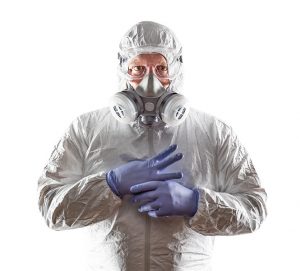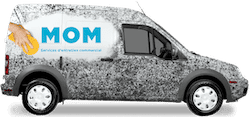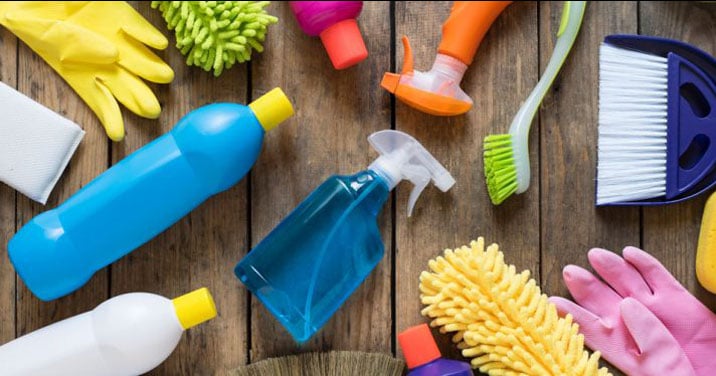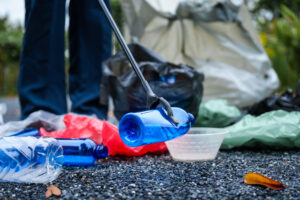When talking about cleaning, people will often use certain words, like cleaning, sanitizing and disinfecting, interchangeably. However, there are key differences between these processes. By having a proper command of the vocabulary, you can help improve your janitorial services by asking for specific services in specific areas around the office.
Cleaning
Cleaning refers to the removal of debris, dirt, stains and dust. Cleaning is usually reserved for low-risk areas such as floors, walls, windows and more. These are considered low-risk because these aren’t areas that are considered prime real estate for the spread of germs. Cleaning is an essential process in order to make any space healthier for those in it. It helps remove allergens, and cleaning also helps create a nicer environment for everyone in it. Even those these areas are considered low-risk, they should be cleaned properly regularly to help maintain a healthy and welcoming environment. Furthermore, these cleaning tasks shouldn’t be too daunting so long as you have the right equipment for the job such as vacuums, brooms and mops.
Sanitizing
 Sanitizing refers to the process of reducing the number of bacteria and fungi on a surface. We usually tend to sanitize contact surfaces, especially in kitchens and bathrooms. While sanitizing a surface does make it free of any visible dirt or potentially harmful bacteria, it does not kill these bacteria. As you’ve seen in the many advertisements for sanitation products, sanitizing a surface removes/kills up to 99.9% of bacteria, but not the whole 100%. Sanitizing does a better job than cleaning by way of reducing the spread of germs. In communal spaces, it is essential that appliances and shared items get sanitized daily. Making sure that the janitorial staff are using proper cleaning products to sanitize areas like the kitchen counters and appliances is the first step in helping to maintain a clean and healthy space. Furthermore, encouraging employees to sanitize their personal areas at the end of the day is a great way to get everyone involved in maintaining a healthy workspace.
Sanitizing refers to the process of reducing the number of bacteria and fungi on a surface. We usually tend to sanitize contact surfaces, especially in kitchens and bathrooms. While sanitizing a surface does make it free of any visible dirt or potentially harmful bacteria, it does not kill these bacteria. As you’ve seen in the many advertisements for sanitation products, sanitizing a surface removes/kills up to 99.9% of bacteria, but not the whole 100%. Sanitizing does a better job than cleaning by way of reducing the spread of germs. In communal spaces, it is essential that appliances and shared items get sanitized daily. Making sure that the janitorial staff are using proper cleaning products to sanitize areas like the kitchen counters and appliances is the first step in helping to maintain a clean and healthy space. Furthermore, encouraging employees to sanitize their personal areas at the end of the day is a great way to get everyone involved in maintaining a healthy workspace.
Disinfecting
 Disinfecting, the strongest method of the three, refers to using a product that will “kill” the bacteria or germs that linger on surfaces. These kinds of products should be used for high-traffic surfaces and areas, as these are the ones that tend to harbour the most germs and bacteria. However, when it comes to food safety, sanitizing is still the safest option. Using a disinfecting product guarantees that there will be no bacteria left behind. Within the range of disinfectants, there are certain products that target specific areas, such as disinfectants for washrooms versus disinfectants everyday surfaces. It is important to communicate with your janitorial staff about having the right disinfectants for the right job. Washrooms, door handles and common areas should be disinfected daily as there is no need to have lingering germs in these areas. Disinfecting wipes should also be made available for employees to use when they are sick in order to wipe down their personal areas to stop the spread of germs.
Disinfecting, the strongest method of the three, refers to using a product that will “kill” the bacteria or germs that linger on surfaces. These kinds of products should be used for high-traffic surfaces and areas, as these are the ones that tend to harbour the most germs and bacteria. However, when it comes to food safety, sanitizing is still the safest option. Using a disinfecting product guarantees that there will be no bacteria left behind. Within the range of disinfectants, there are certain products that target specific areas, such as disinfectants for washrooms versus disinfectants everyday surfaces. It is important to communicate with your janitorial staff about having the right disinfectants for the right job. Washrooms, door handles and common areas should be disinfected daily as there is no need to have lingering germs in these areas. Disinfecting wipes should also be made available for employees to use when they are sick in order to wipe down their personal areas to stop the spread of germs.
With this vocabulary distinction in hand, you should be able to confidently talk to your janitorial service staff about how to maintain your workspace healthy and germ free!



